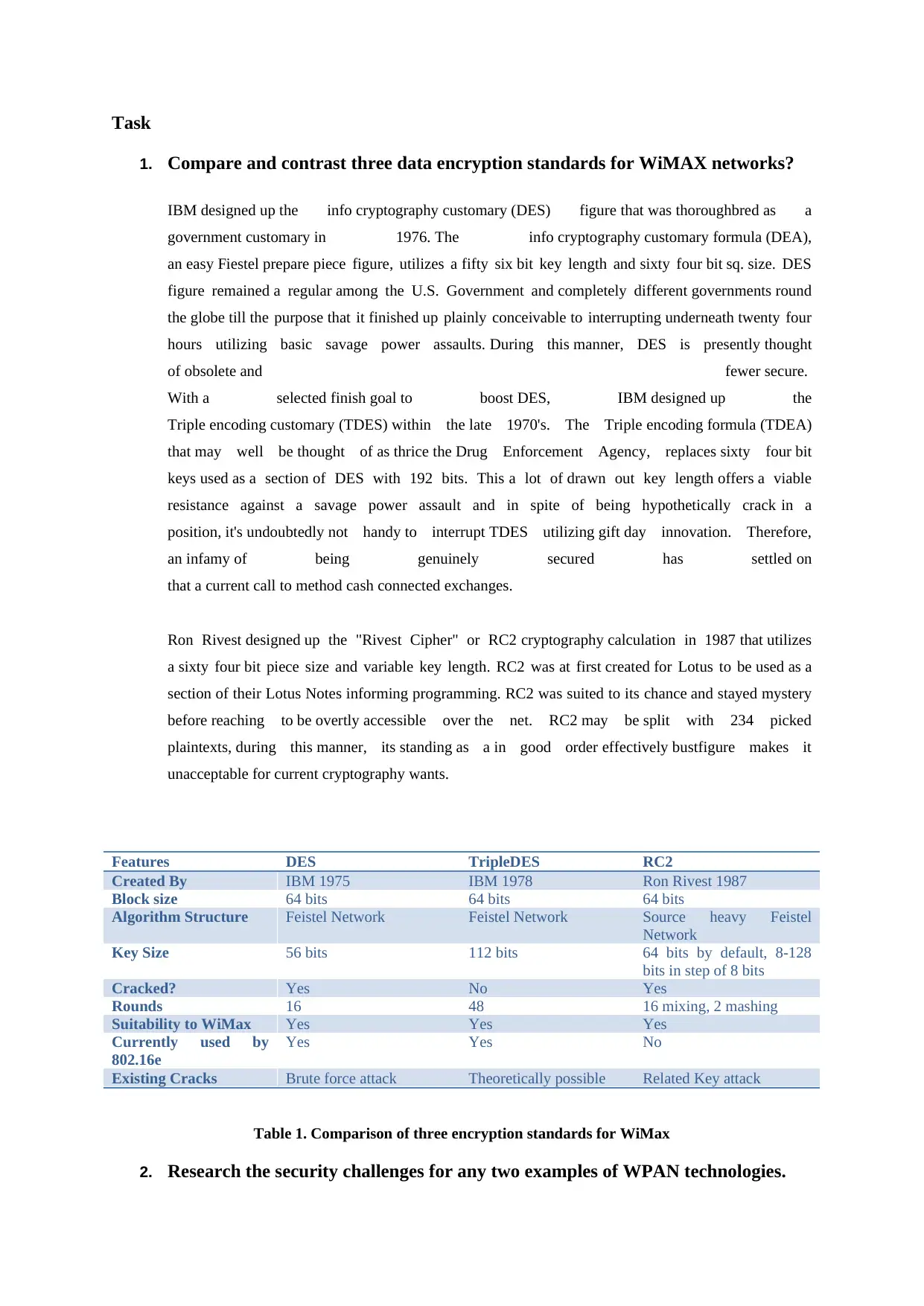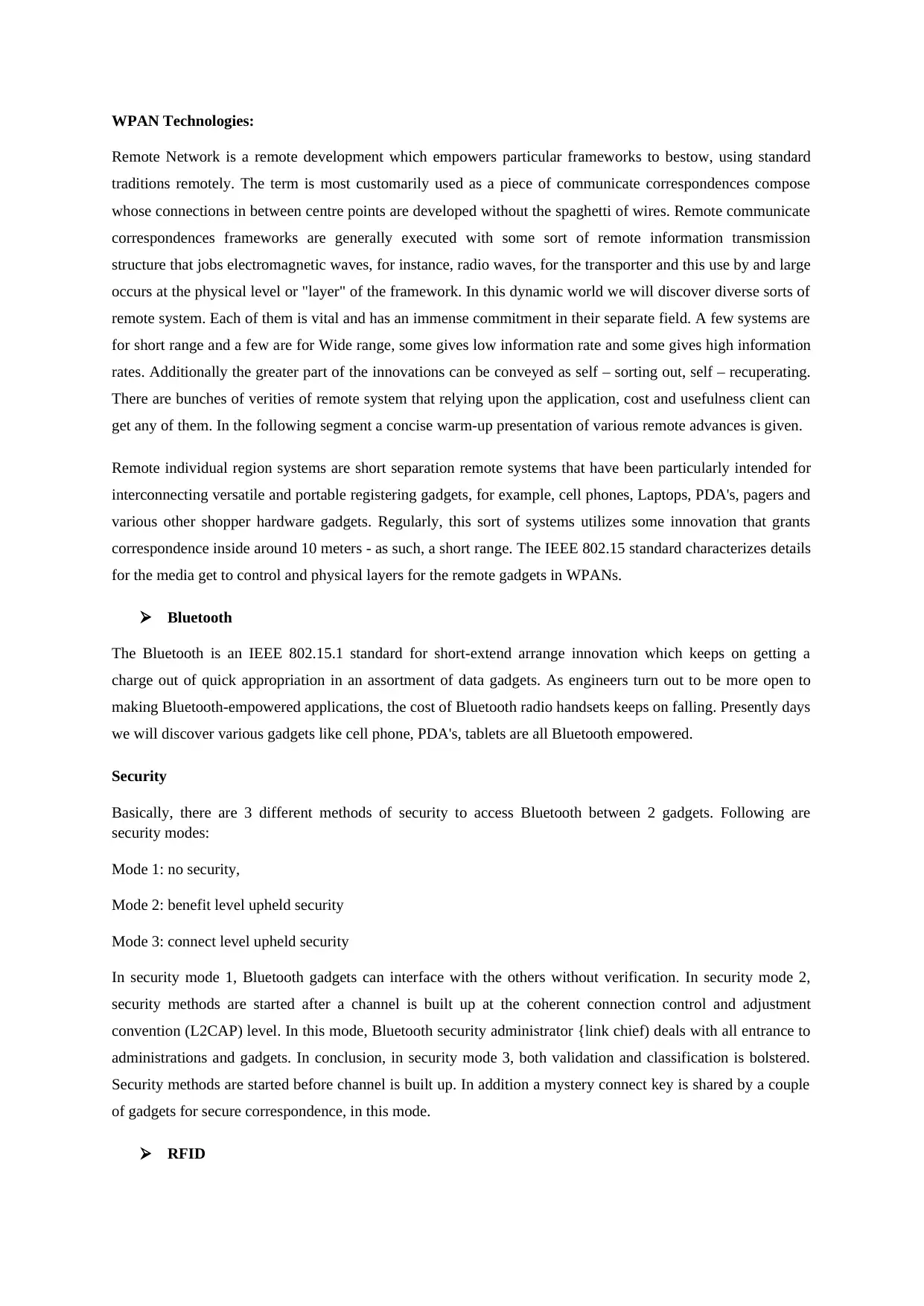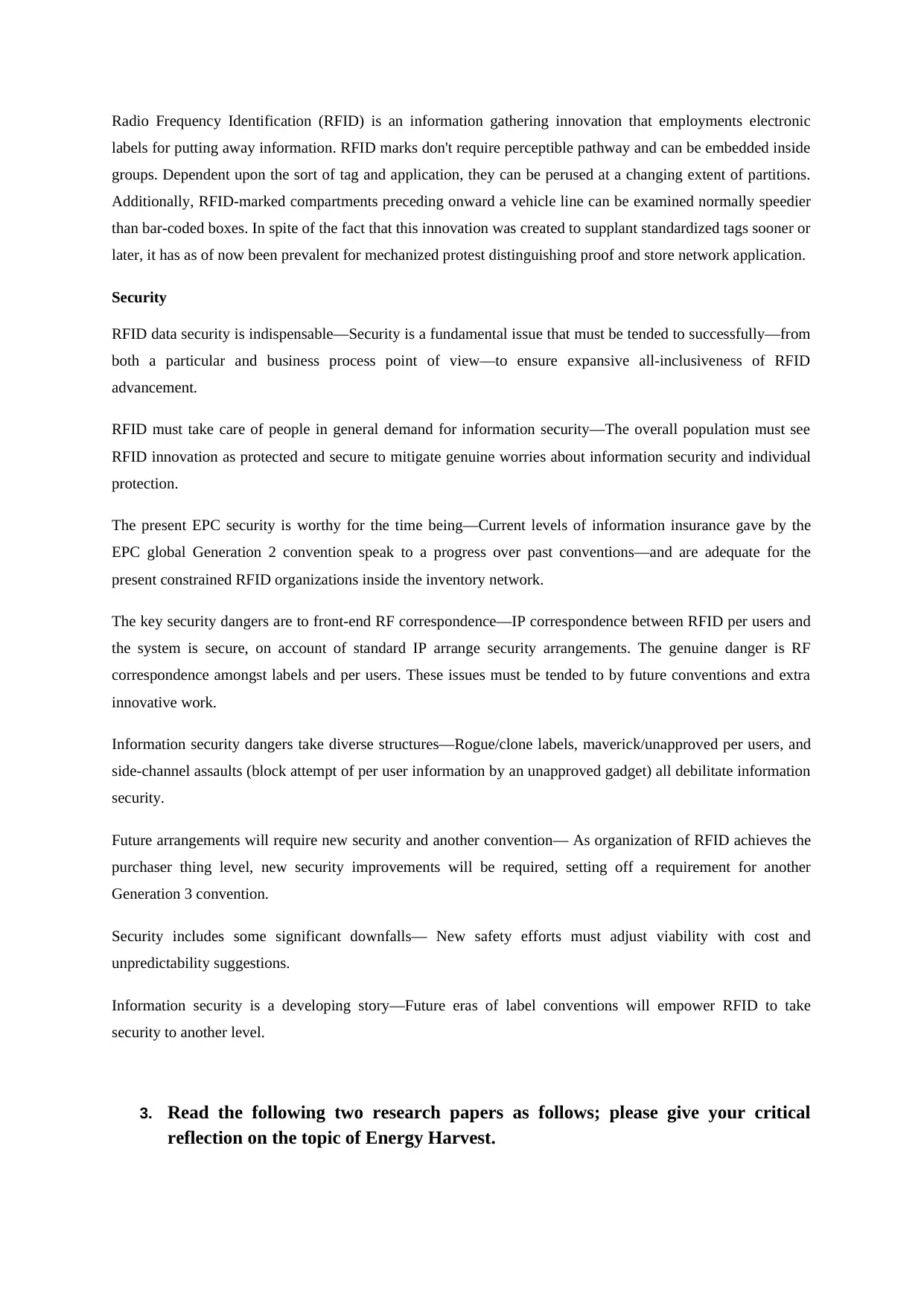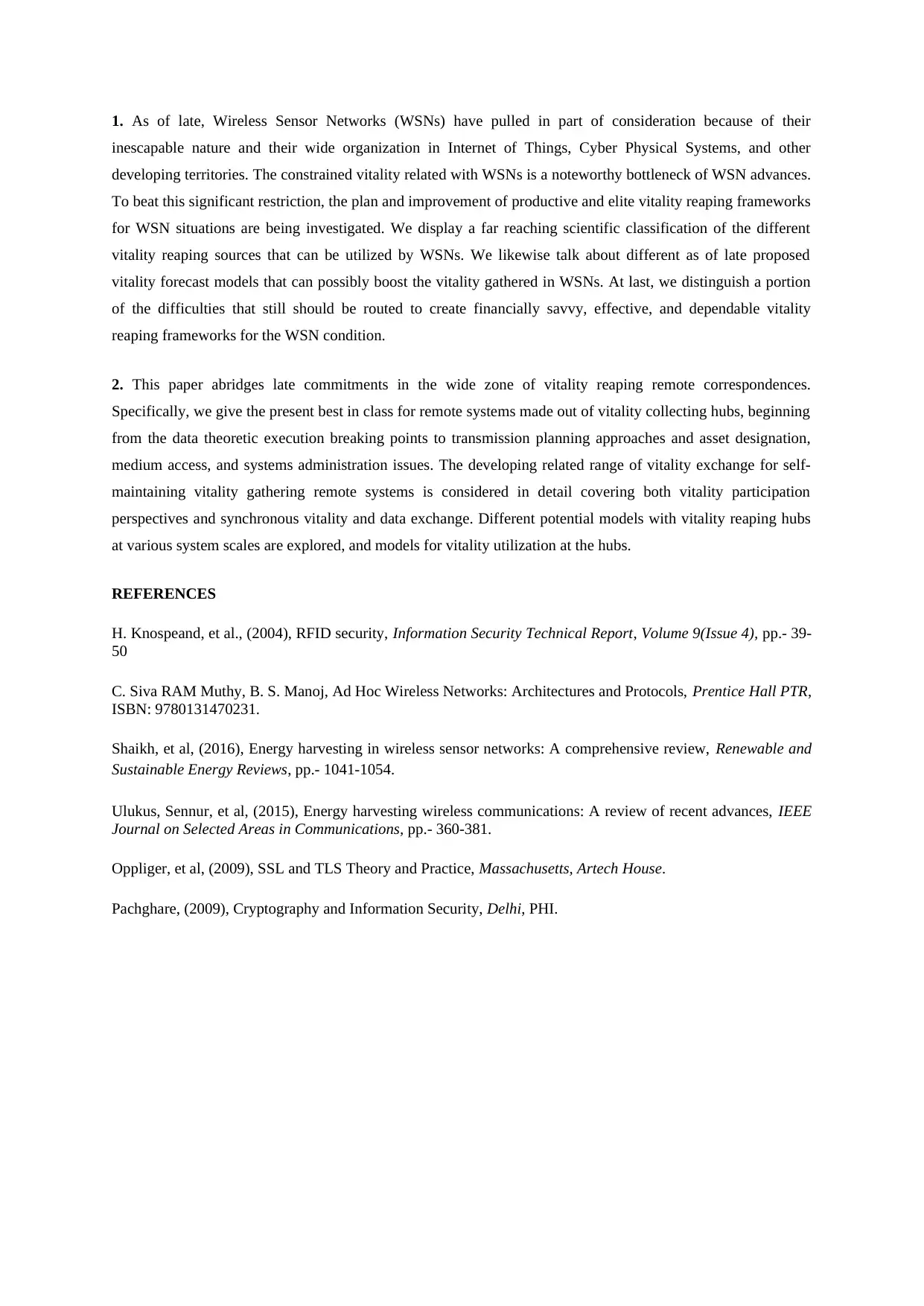Comparison of Encryption Standards for WiMAX Networks and Security
VerifiedAdded on 2020/03/23
|4
|1773
|49
Homework Assignment
AI Summary
This assignment delves into several key areas of computer science and networking. Firstly, it compares and contrasts three data encryption standards (DES, TripleDES, and RC2) used in WiMAX networks, evaluating their strengths, weaknesses, and suitability. Secondly, it examines security challenges within two WPAN technologies, specifically Bluetooth and RFID, exploring their security modes and vulnerabilities. Finally, the assignment requires a critical reflection on two research papers related to energy harvesting in wireless sensor networks (WSNs). The reflection analyzes different energy harvesting sources, energy prediction models, and the challenges associated with developing cost-effective and reliable energy harvesting systems for WSN environments, as well as the latest advancements in the field of energy harvesting for wireless communications, including energy cooperation and synchronous energy/information exchange.

Task
1. Compare and contrast three data encryption standards for WiMAX networks?
IBM designed up the info cryptography customary (DES) figure that was thoroughbred as a
government customary in 1976. The info cryptography customary formula (DEA),
an easy Fiestel prepare piece figure, utilizes a fifty six bit key length and sixty four bit sq. size. DES
figure remained a regular among the U.S. Government and completely different governments round
the globe till the purpose that it finished up plainly conceivable to interrupting underneath twenty four
hours utilizing basic savage power assaults. During this manner, DES is presently thought
of obsolete and fewer secure.
With a selected finish goal to boost DES, IBM designed up the
Triple encoding customary (TDES) within the late 1970's. The Triple encoding formula (TDEA)
that may well be thought of as thrice the Drug Enforcement Agency, replaces sixty four bit
keys used as a section of DES with 192 bits. This a lot of drawn out key length offers a viable
resistance against a savage power assault and in spite of being hypothetically crack in a
position, it's undoubtedly not handy to interrupt TDES utilizing gift day innovation. Therefore,
an infamy of being genuinely secured has settled on
that a current call to method cash connected exchanges.
Ron Rivest designed up the "Rivest Cipher" or RC2 cryptography calculation in 1987 that utilizes
a sixty four bit piece size and variable key length. RC2 was at first created for Lotus to be used as a
section of their Lotus Notes informing programming. RC2 was suited to its chance and stayed mystery
before reaching to be overtly accessible over the net. RC2 may be split with 234 picked
plaintexts, during this manner, its standing as a in good order effectively bustfigure makes it
unacceptable for current cryptography wants.
Features DES TripleDES RC2
Created By IBM 1975 IBM 1978 Ron Rivest 1987
Block size 64 bits 64 bits 64 bits
Algorithm Structure Feistel Network Feistel Network Source heavy Feistel
Network
Key Size 56 bits 112 bits 64 bits by default, 8-128
bits in step of 8 bits
Cracked? Yes No Yes
Rounds 16 48 16 mixing, 2 mashing
Suitability to WiMax Yes Yes Yes
Currently used by
802.16e
Yes Yes No
Existing Cracks Brute force attack Theoretically possible Related Key attack
Table 1. Comparison of three encryption standards for WiMax
2. Research the security challenges for any two examples of WPAN technologies.
1. Compare and contrast three data encryption standards for WiMAX networks?
IBM designed up the info cryptography customary (DES) figure that was thoroughbred as a
government customary in 1976. The info cryptography customary formula (DEA),
an easy Fiestel prepare piece figure, utilizes a fifty six bit key length and sixty four bit sq. size. DES
figure remained a regular among the U.S. Government and completely different governments round
the globe till the purpose that it finished up plainly conceivable to interrupting underneath twenty four
hours utilizing basic savage power assaults. During this manner, DES is presently thought
of obsolete and fewer secure.
With a selected finish goal to boost DES, IBM designed up the
Triple encoding customary (TDES) within the late 1970's. The Triple encoding formula (TDEA)
that may well be thought of as thrice the Drug Enforcement Agency, replaces sixty four bit
keys used as a section of DES with 192 bits. This a lot of drawn out key length offers a viable
resistance against a savage power assault and in spite of being hypothetically crack in a
position, it's undoubtedly not handy to interrupt TDES utilizing gift day innovation. Therefore,
an infamy of being genuinely secured has settled on
that a current call to method cash connected exchanges.
Ron Rivest designed up the "Rivest Cipher" or RC2 cryptography calculation in 1987 that utilizes
a sixty four bit piece size and variable key length. RC2 was at first created for Lotus to be used as a
section of their Lotus Notes informing programming. RC2 was suited to its chance and stayed mystery
before reaching to be overtly accessible over the net. RC2 may be split with 234 picked
plaintexts, during this manner, its standing as a in good order effectively bustfigure makes it
unacceptable for current cryptography wants.
Features DES TripleDES RC2
Created By IBM 1975 IBM 1978 Ron Rivest 1987
Block size 64 bits 64 bits 64 bits
Algorithm Structure Feistel Network Feistel Network Source heavy Feistel
Network
Key Size 56 bits 112 bits 64 bits by default, 8-128
bits in step of 8 bits
Cracked? Yes No Yes
Rounds 16 48 16 mixing, 2 mashing
Suitability to WiMax Yes Yes Yes
Currently used by
802.16e
Yes Yes No
Existing Cracks Brute force attack Theoretically possible Related Key attack
Table 1. Comparison of three encryption standards for WiMax
2. Research the security challenges for any two examples of WPAN technologies.
Paraphrase This Document
Need a fresh take? Get an instant paraphrase of this document with our AI Paraphraser

WPAN Technologies:
Remote Network is a remote development which empowers particular frameworks to bestow, using standard
traditions remotely. The term is most customarily used as a piece of communicate correspondences compose
whose connections in between centre points are developed without the spaghetti of wires. Remote communicate
correspondences frameworks are generally executed with some sort of remote information transmission
structure that jobs electromagnetic waves, for instance, radio waves, for the transporter and this use by and large
occurs at the physical level or "layer" of the framework. In this dynamic world we will discover diverse sorts of
remote system. Each of them is vital and has an immense commitment in their separate field. A few systems are
for short range and a few are for Wide range, some gives low information rate and some gives high information
rates. Additionally the greater part of the innovations can be conveyed as self – sorting out, self – recuperating.
There are bunches of verities of remote system that relying upon the application, cost and usefulness client can
get any of them. In the following segment a concise warm-up presentation of various remote advances is given.
Remote individual region systems are short separation remote systems that have been particularly intended for
interconnecting versatile and portable registering gadgets, for example, cell phones, Laptops, PDA's, pagers and
various other shopper hardware gadgets. Regularly, this sort of systems utilizes some innovation that grants
correspondence inside around 10 meters - as such, a short range. The IEEE 802.15 standard characterizes details
for the media get to control and physical layers for the remote gadgets in WPANs.
Bluetooth
The Bluetooth is an IEEE 802.15.1 standard for short-extend arrange innovation which keeps on getting a
charge out of quick appropriation in an assortment of data gadgets. As engineers turn out to be more open to
making Bluetooth-empowered applications, the cost of Bluetooth radio handsets keeps on falling. Presently days
we will discover various gadgets like cell phone, PDA's, tablets are all Bluetooth empowered.
Security
Basically, there are 3 different methods of security to access Bluetooth between 2 gadgets. Following are
security modes:
Mode 1: no security,
Mode 2: benefit level upheld security
Mode 3: connect level upheld security
In security mode 1, Bluetooth gadgets can interface with the others without verification. In security mode 2,
security methods are started after a channel is built up at the coherent connection control and adjustment
convention (L2CAP) level. In this mode, Bluetooth security administrator {link chief) deals with all entrance to
administrations and gadgets. In conclusion, in security mode 3, both validation and classification is bolstered.
Security methods are started before channel is built up. In addition a mystery connect key is shared by a couple
of gadgets for secure correspondence, in this mode.
RFID
Remote Network is a remote development which empowers particular frameworks to bestow, using standard
traditions remotely. The term is most customarily used as a piece of communicate correspondences compose
whose connections in between centre points are developed without the spaghetti of wires. Remote communicate
correspondences frameworks are generally executed with some sort of remote information transmission
structure that jobs electromagnetic waves, for instance, radio waves, for the transporter and this use by and large
occurs at the physical level or "layer" of the framework. In this dynamic world we will discover diverse sorts of
remote system. Each of them is vital and has an immense commitment in their separate field. A few systems are
for short range and a few are for Wide range, some gives low information rate and some gives high information
rates. Additionally the greater part of the innovations can be conveyed as self – sorting out, self – recuperating.
There are bunches of verities of remote system that relying upon the application, cost and usefulness client can
get any of them. In the following segment a concise warm-up presentation of various remote advances is given.
Remote individual region systems are short separation remote systems that have been particularly intended for
interconnecting versatile and portable registering gadgets, for example, cell phones, Laptops, PDA's, pagers and
various other shopper hardware gadgets. Regularly, this sort of systems utilizes some innovation that grants
correspondence inside around 10 meters - as such, a short range. The IEEE 802.15 standard characterizes details
for the media get to control and physical layers for the remote gadgets in WPANs.
Bluetooth
The Bluetooth is an IEEE 802.15.1 standard for short-extend arrange innovation which keeps on getting a
charge out of quick appropriation in an assortment of data gadgets. As engineers turn out to be more open to
making Bluetooth-empowered applications, the cost of Bluetooth radio handsets keeps on falling. Presently days
we will discover various gadgets like cell phone, PDA's, tablets are all Bluetooth empowered.
Security
Basically, there are 3 different methods of security to access Bluetooth between 2 gadgets. Following are
security modes:
Mode 1: no security,
Mode 2: benefit level upheld security
Mode 3: connect level upheld security
In security mode 1, Bluetooth gadgets can interface with the others without verification. In security mode 2,
security methods are started after a channel is built up at the coherent connection control and adjustment
convention (L2CAP) level. In this mode, Bluetooth security administrator {link chief) deals with all entrance to
administrations and gadgets. In conclusion, in security mode 3, both validation and classification is bolstered.
Security methods are started before channel is built up. In addition a mystery connect key is shared by a couple
of gadgets for secure correspondence, in this mode.
RFID

Radio Frequency Identification (RFID) is an information gathering innovation that employments electronic
labels for putting away information. RFID marks don't require perceptible pathway and can be embedded inside
groups. Dependent upon the sort of tag and application, they can be perused at a changing extent of partitions.
Additionally, RFID-marked compartments preceding onward a vehicle line can be examined normally speedier
than bar-coded boxes. In spite of the fact that this innovation was created to supplant standardized tags sooner or
later, it has as of now been prevalent for mechanized protest distinguishing proof and store network application.
Security
RFID data security is indispensable—Security is a fundamental issue that must be tended to successfully—from
both a particular and business process point of view—to ensure expansive all-inclusiveness of RFID
advancement.
RFID must take care of people in general demand for information security—The overall population must see
RFID innovation as protected and secure to mitigate genuine worries about information security and individual
protection.
The present EPC security is worthy for the time being—Current levels of information insurance gave by the
EPC global Generation 2 convention speak to a progress over past conventions—and are adequate for the
present constrained RFID organizations inside the inventory network.
The key security dangers are to front-end RF correspondence—IP correspondence between RFID per users and
the system is secure, on account of standard IP arrange security arrangements. The genuine danger is RF
correspondence amongst labels and per users. These issues must be tended to by future conventions and extra
innovative work.
Information security dangers take diverse structures—Rogue/clone labels, maverick/unapproved per users, and
side-channel assaults (block attempt of per user information by an unapproved gadget) all debilitate information
security.
Future arrangements will require new security and another convention— As organization of RFID achieves the
purchaser thing level, new security improvements will be required, setting off a requirement for another
Generation 3 convention.
Security includes some significant downfalls— New safety efforts must adjust viability with cost and
unpredictability suggestions.
Information security is a developing story—Future eras of label conventions will empower RFID to take
security to another level.
3. Read the following two research papers as follows; please give your critical
reflection on the topic of Energy Harvest.
labels for putting away information. RFID marks don't require perceptible pathway and can be embedded inside
groups. Dependent upon the sort of tag and application, they can be perused at a changing extent of partitions.
Additionally, RFID-marked compartments preceding onward a vehicle line can be examined normally speedier
than bar-coded boxes. In spite of the fact that this innovation was created to supplant standardized tags sooner or
later, it has as of now been prevalent for mechanized protest distinguishing proof and store network application.
Security
RFID data security is indispensable—Security is a fundamental issue that must be tended to successfully—from
both a particular and business process point of view—to ensure expansive all-inclusiveness of RFID
advancement.
RFID must take care of people in general demand for information security—The overall population must see
RFID innovation as protected and secure to mitigate genuine worries about information security and individual
protection.
The present EPC security is worthy for the time being—Current levels of information insurance gave by the
EPC global Generation 2 convention speak to a progress over past conventions—and are adequate for the
present constrained RFID organizations inside the inventory network.
The key security dangers are to front-end RF correspondence—IP correspondence between RFID per users and
the system is secure, on account of standard IP arrange security arrangements. The genuine danger is RF
correspondence amongst labels and per users. These issues must be tended to by future conventions and extra
innovative work.
Information security dangers take diverse structures—Rogue/clone labels, maverick/unapproved per users, and
side-channel assaults (block attempt of per user information by an unapproved gadget) all debilitate information
security.
Future arrangements will require new security and another convention— As organization of RFID achieves the
purchaser thing level, new security improvements will be required, setting off a requirement for another
Generation 3 convention.
Security includes some significant downfalls— New safety efforts must adjust viability with cost and
unpredictability suggestions.
Information security is a developing story—Future eras of label conventions will empower RFID to take
security to another level.
3. Read the following two research papers as follows; please give your critical
reflection on the topic of Energy Harvest.
⊘ This is a preview!⊘
Do you want full access?
Subscribe today to unlock all pages.

Trusted by 1+ million students worldwide

1. As of late, Wireless Sensor Networks (WSNs) have pulled in part of consideration because of their
inescapable nature and their wide organization in Internet of Things, Cyber Physical Systems, and other
developing territories. The constrained vitality related with WSNs is a noteworthy bottleneck of WSN advances.
To beat this significant restriction, the plan and improvement of productive and elite vitality reaping frameworks
for WSN situations are being investigated. We display a far reaching scientific classification of the different
vitality reaping sources that can be utilized by WSNs. We likewise talk about different as of late proposed
vitality forecast models that can possibly boost the vitality gathered in WSNs. At last, we distinguish a portion
of the difficulties that still should be routed to create financially savvy, effective, and dependable vitality
reaping frameworks for the WSN condition.
2. This paper abridges late commitments in the wide zone of vitality reaping remote correspondences.
Specifically, we give the present best in class for remote systems made out of vitality collecting hubs, beginning
from the data theoretic execution breaking points to transmission planning approaches and asset designation,
medium access, and systems administration issues. The developing related range of vitality exchange for self-
maintaining vitality gathering remote systems is considered in detail covering both vitality participation
perspectives and synchronous vitality and data exchange. Different potential models with vitality reaping hubs
at various system scales are explored, and models for vitality utilization at the hubs.
REFERENCES
H. Knospeand, et al., (2004), RFID security, Information Security Technical Report, Volume 9(Issue 4), pp.- 39-
50
C. Siva RAM Muthy, B. S. Manoj, Ad Hoc Wireless Networks: Architectures and Protocols, Prentice Hall PTR,
ISBN: 9780131470231.
Shaikh, et al, (2016), Energy harvesting in wireless sensor networks: A comprehensive review, Renewable and
Sustainable Energy Reviews, pp.- 1041-1054.
Ulukus, Sennur, et al, (2015), Energy harvesting wireless communications: A review of recent advances, IEEE
Journal on Selected Areas in Communications, pp.- 360-381.
Oppliger, et al, (2009), SSL and TLS Theory and Practice, Massachusetts, Artech House.
Pachghare, (2009), Cryptography and Information Security, Delhi, PHI.
inescapable nature and their wide organization in Internet of Things, Cyber Physical Systems, and other
developing territories. The constrained vitality related with WSNs is a noteworthy bottleneck of WSN advances.
To beat this significant restriction, the plan and improvement of productive and elite vitality reaping frameworks
for WSN situations are being investigated. We display a far reaching scientific classification of the different
vitality reaping sources that can be utilized by WSNs. We likewise talk about different as of late proposed
vitality forecast models that can possibly boost the vitality gathered in WSNs. At last, we distinguish a portion
of the difficulties that still should be routed to create financially savvy, effective, and dependable vitality
reaping frameworks for the WSN condition.
2. This paper abridges late commitments in the wide zone of vitality reaping remote correspondences.
Specifically, we give the present best in class for remote systems made out of vitality collecting hubs, beginning
from the data theoretic execution breaking points to transmission planning approaches and asset designation,
medium access, and systems administration issues. The developing related range of vitality exchange for self-
maintaining vitality gathering remote systems is considered in detail covering both vitality participation
perspectives and synchronous vitality and data exchange. Different potential models with vitality reaping hubs
at various system scales are explored, and models for vitality utilization at the hubs.
REFERENCES
H. Knospeand, et al., (2004), RFID security, Information Security Technical Report, Volume 9(Issue 4), pp.- 39-
50
C. Siva RAM Muthy, B. S. Manoj, Ad Hoc Wireless Networks: Architectures and Protocols, Prentice Hall PTR,
ISBN: 9780131470231.
Shaikh, et al, (2016), Energy harvesting in wireless sensor networks: A comprehensive review, Renewable and
Sustainable Energy Reviews, pp.- 1041-1054.
Ulukus, Sennur, et al, (2015), Energy harvesting wireless communications: A review of recent advances, IEEE
Journal on Selected Areas in Communications, pp.- 360-381.
Oppliger, et al, (2009), SSL and TLS Theory and Practice, Massachusetts, Artech House.
Pachghare, (2009), Cryptography and Information Security, Delhi, PHI.
1 out of 4
Your All-in-One AI-Powered Toolkit for Academic Success.
+13062052269
info@desklib.com
Available 24*7 on WhatsApp / Email
![[object Object]](/_next/static/media/star-bottom.7253800d.svg)
Unlock your academic potential
Copyright © 2020–2025 A2Z Services. All Rights Reserved. Developed and managed by ZUCOL.

